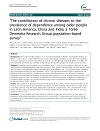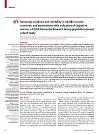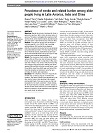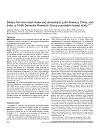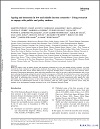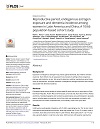Buscar
Mostrando ítems 1-10 de 19
The contribution of chronic diseases to the prevalence of dependence among older people in Latin America, China and India: a 10/66 Dementia Research Group population-based survey
(BMC Geriatrics, 2010-08-06)
The number of older people is set to increase dramatically worldwide. Demographic changes are
likely to result in the rise of age-related chronic diseases which largely contribute to years lived with a disability and ...
Dementia incidence and mortality in middle-income countries, and associations with indicators of cognitive reserve: a 10/66 Dementia Research Group population-based cohort study
(The Lancet, 2012)
Results of the few cohort studies from countries with low incomes or middle incomes suggest a lower incidence of dementia than in high-income countries. We assessed incidence of dementia according to criteria from the 10/66 ...
Measuring disability across cultures the psychometric properties of the WHODAS II in older people from seven low- And middle-income countries. the 10/66 Dementia research group population-based survey
(International Journal of Methods in Psychiatric Research, 2010)
We evaluated the psychometric properties of the 12-item intervieweradministered screener version of the World Health Organization Disability Assessment Schedule – version II (WHODAS II) among older people living in seven ...
Strain and its correlates among carers of people with dementia in low-income and middle-income countries. A 10/66 Dementia Research Group population-based survey.
(International Journal of Geriatric Psychiatry, 2012)
In a multi-site population-based study in several middle-income countries, we aimed to investigate relative contributions of care arrangements and characteristics of carers and care recipients to strain among carers of ...
Equity in the delivery of community healthcare to older people: Findings from 10/66 Dementia research group cross-sectional surveys in Latin America, China, India and Nigeria.
(BMC Health Services Research, 2011)
To describe patterns of recent health service utilisation, and consequent out-of-pocket expenses among older people in countries with low and middle incomes, and to assess the equity with which services are accessed and ...
Prevalence of stroke and related burden among older people living in Latin America, India and China.
(Journal of Neurology, Neurosurgery and Psychiatry, 2011)
Despite the growing importance of stroke in developing countries, little is known of stroke burden in survivors. The authors investigated the prevalence of selfreported stroke, stroke-related disability, dependence and ...
Dietary fish and meat intake and dementia in Latin America, China, and India: A 10/66 Dementia Research Group
(American Journal o f Clinical Nutrition, 2009)
Evidence of an association between fish and meat consumption and risk of dementia is inconsistent and nonexistent in populations in developing countries. Objective: The objective was to investigate associations between ...
Ageing and dementia in low and middle income countries - Using research to engage with public and policy makers.
(In ternational Review of Psychiatry, 2008)
While two thirds of the 24 million people with dementia worldwide live in low and middle income countries, very little research has been conducted to support policy making in these regions. Among the non-communicable ...
A brief dementia screener suitable for use by non-specialists in resource poor settings-the cross-cultural derivation and validation of the brief Community Screening Instrument for Dementia.
(International Journal of Geriatric Psychiatry, 2011)
Brief screening tools for dementia for use by non-specialists in primary care have yet to be validated in nonwestern settings where cultural factors and limited education may complicate the task. We aimed to derive a brief ...
Reproductive period, endogenous estrogen exposure and dementia incidence among women in Latin America and China: a 10/66 population-based cohort study.
(PloS Medicine, 2018)
Exposure to endogenous estrogen may protect against dementia, but evidence remains equivocal. Such effects
may be assessed more precisely in settings where exogenous estrogen administration is rare. We aimed to ...


